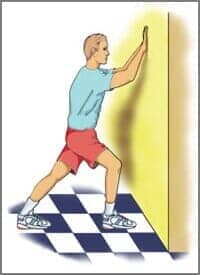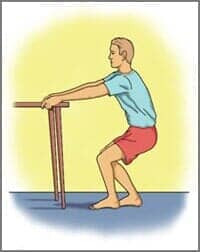Patient Information
Patient Information
Patient Information
In case you have misplaced the information given to you during your visit, we have provided the information below.
Achilles Tendon Stretching Exercises
The Achilles tendon is made up of two separate muscles: the gastrocnemius and the soleus. Therefore, we recommend two different exercises to stretch each:

Exercise #1 (Gasctroc Stretch)
- Lean forward against a wall with both feet directly in-line (parallel) with each other.
- Your back knee is completely straight.
- Your back heel must remain on the floor at all times.
- Your front knee is bent.
- Lean forward against the wall, keeping the back knee straight and the back heel on the ground at all times.
- Your calf, heel cord and foot arch stretch as you lean.
- Hold for 10 seconds, relax and straighten up.
- Repeat 20-30 times for each foot.
Exercise #2 (Soleus Stretch)
- Lean forward against a counter-top or wall with both feet directly in-line (parallel) with each other.
- Flex your knees and squat down, keeping your heels on the ground as long as possible.
- Your lower calf, heel cord and foot arch stretch as you flex.
- Hold for 10 seconds, relax and straighten up.
- Repeat 20-30 times for each foot.

1. You have been given a prescription for pain medication. Take as instructed.
2. Keep your leg elevated, above the level of your heart, over the next few days.
Read More
3. You have been given a: Surgical Shoe / Walking Cast / Posterior Mold
• wear this at all times when walking post-operatively.
• if you have been given crutches or a walker, use them as instructed.
4. Keep your dressing: Clean, Dry and Do Not Remove It.
• If your dressing gets wet or falls off, Call Your Doctor! 5. If you experience:
• Excessive bleeding, drainage or redness
• Fever of 100 degrees or greater
• Pain, numbness, and tingling not relieved with pain medication Call Your Doctor!
• Slight bleeding on the bandage may occur. This is expected and OK.
In the event of an emergency involving your surgery, call the office and have the operator reach the doctor on call.
• wear this at all times when walking post-operatively.
• if you have been given crutches or a walker, use them as instructed.
4. Keep your dressing: Clean, Dry and Do Not Remove It.
• If your dressing gets wet or falls off, Call Your Doctor! 5. If you experience:
• Excessive bleeding, drainage or redness
• Fever of 100 degrees or greater
• Pain, numbness, and tingling not relieved with pain medication Call Your Doctor!
• Slight bleeding on the bandage may occur. This is expected and OK.
In the event of an emergency involving your surgery, call the office and have the operator reach the doctor on call.
Post-Operative Instructions
1. You have been given a prescription for pain medication. Take as instructed.
2. Keep your leg elevated, above the level of your heart, over the next few days.
3. You have been given a: Surgical Shoe / Walking Cast / Posterior Mold
Read More
• wear this at all times when walking post-operatively.
• if you have been given crutches or a walker, use them as instructed.
4.Keep your dressing: Clean, Dry and Do Not Remove It.
• if your dressing gets wet or falls off, Call Your Doctor!
5.If you experience:
• Excessive bleeding, drainage or redness
• Fever of 100 degrees or greater
• Pain, numbness and tingling not relieved with pain medication
• if you have been given crutches or a walker, use them as instructed.
4.Keep your dressing: Clean, Dry and Do Not Remove It.
• if your dressing gets wet or falls off, Call Your Doctor!
5.If you experience:
• Excessive bleeding, drainage or redness
• Fever of 100 degrees or greater
• Pain, numbness and tingling not relieved with pain medication
Post-Op Nail Procedure Instructions
1. You have been given a prescription for pain medication. Take as instructed.
2. Keep your leg elevated, above the level of your heart, over the next few days.
Read More
3. You have been given a: Surgical Shoe / Walking Cast / Posterior Mold
• wear this at all times when walking post-operatively.
• if you have been given crutches or a walker, use them as instructed.
4. Keep your dressing: Clean, Dry and Do Not Remove It.
• If your dressing gets wet or falls off, Call Your Doctor!
5. If you experience:
• Excessive bleeding, drainage or redness
• Fever of 100 degrees or greater
• Pain, numbness and tingling not relieved with pain medication Call Your Doctor!
• Slight bleeding on the bandage may occur. This is expected and OK. In the event of an emergency involving your surgery, call the office and have the operator reach the doctor on call.
• wear this at all times when walking post-operatively.
• if you have been given crutches or a walker, use them as instructed.
4. Keep your dressing: Clean, Dry and Do Not Remove It.
• If your dressing gets wet or falls off, Call Your Doctor!
5. If you experience:
• Excessive bleeding, drainage or redness
• Fever of 100 degrees or greater
• Pain, numbness and tingling not relieved with pain medication Call Your Doctor!
• Slight bleeding on the bandage may occur. This is expected and OK. In the event of an emergency involving your surgery, call the office and have the operator reach the doctor on call.
Caring for your Cast
Unless specifically instructed, you should not place any weight on the leg which has the cast. Use your crutches or walker as instructed by the doctor or physical therapist. It is necessary to keep the cast clean and dry.
Your toes should be pink and you should be able to move them freely.
If you experience numbness of the toes, feel that the cast is cutting your skin, or have pain which is not relieved by your pain medication, please call your doctor.
Orthotic Break-In Recommendations
Your orthotic device has been designed and built to help your specific foot condition. By using the impressions we made of your feet and our careful study of your foot condition, we've created a device custom-made for your feet.
However, your device is not a "cure all". Depending on your working conditions, shoe choices, the number of hours on your feet and the specific foot condition, you probably will have some symptoms.
Read More
It has been our experience, however, that as long as you wear your orthotics in shoes that allow them to work:
• your symptoms should decrease
• you should be able to have longer periods of time without pain or discomfort
• you will eventually arrive at a stable condition, needing only occasional treatment and examination of your feet
Many patients have no difficulty wearing their orthotic devices. They feel comfortable from the first day. However, some patients feel tired or have a discomfort in their feet and legs. This is because their muscles must get used to the new, proper alignment of your feet and legs.
If you experience this problem:
1. Remove your orthotic from your shoe.
2. After one hour, put your orthotic back into your shoe.
3. If your orthotic becomes uncomfortable, remove it again.
4. Each time, you should be able to wear your orthotic a little longer. Follow this routine until you can wear it comfortably for the entire day.
5. NEVER FORCE YOURSELF TO WEAR YOUR ORTHOTIC DEVICE.
6. We may need to make minor adjustments to your device before it becomes completely comfortable.
7. Larger footgear (depending upon shoe style) may be necessary to accommodate your foot and orthotic.
If your orthotic device "squeaks" in your shoe, use foot powder to dust under the surfaces where the orthotic touches your shoes.Your foot may slip somewhat in the heel of the shoe until your orthotic becomes seated. Slipping will stop when it becomes seated.
• your symptoms should decrease
• you should be able to have longer periods of time without pain or discomfort
• you will eventually arrive at a stable condition, needing only occasional treatment and examination of your feet
Many patients have no difficulty wearing their orthotic devices. They feel comfortable from the first day. However, some patients feel tired or have a discomfort in their feet and legs. This is because their muscles must get used to the new, proper alignment of your feet and legs.
If you experience this problem:
1. Remove your orthotic from your shoe.
2. After one hour, put your orthotic back into your shoe.
3. If your orthotic becomes uncomfortable, remove it again.
4. Each time, you should be able to wear your orthotic a little longer. Follow this routine until you can wear it comfortably for the entire day.
5. NEVER FORCE YOURSELF TO WEAR YOUR ORTHOTIC DEVICE.
6. We may need to make minor adjustments to your device before it becomes completely comfortable.
7. Larger footgear (depending upon shoe style) may be necessary to accommodate your foot and orthotic.
If your orthotic device "squeaks" in your shoe, use foot powder to dust under the surfaces where the orthotic touches your shoes.Your foot may slip somewhat in the heel of the shoe until your orthotic becomes seated. Slipping will stop when it becomes seated.
Contact Information
Phone:
773-296-7160
Chicago Location:
3000 North Halsted Suite 801 Chicago, Illinois 60657
Tinley Park Location: 17019 Harlem Avenue, Tinley Park, Illinois 60477
Hours of Operation
- Sunday
- Closed
- Monday
- -
- Tuesday
- -
- Wed - Thu
- -
- Friday
- -
- Saturday
- -
Browse Our Website
Contact Information
Phone:
773-296-7160
Chicago Location:
3000 North Halsted Suite 801
Chicago, Illinois 60657
Tinley Park Location: 17019 Harlem Avenue, Tinley Park, Illinois 60477
Hours of Operation
- Sunday
- Closed
- Monday
- -
- Tuesday
- -
- Wed - Thu
- -
- Friday
- -
- Saturday
- -
Content, including images, displayed on this website is protected by copyright laws. Downloading, republication, retransmission or reproduction of content on this website is strictly prohibited. Terms of Use
| Privacy Policy
